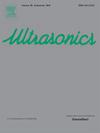超高速旋转超声微孔加工硅片:麻花钻与金刚石刀具的对比研究
IF 4.1
2区 物理与天体物理
Q1 ACOUSTICS
引用次数: 0
摘要
硅在当今的数字世界中扮演着至关重要的角色,尤其是在半导体行业。微孔加工在制造不同的硅基半导体器件,包括传感器,致动器和微系统是必不可少的。然而,硅的高脆性带来了重大的加工挑战,如可加工性降低、刀具快速磨损和开裂风险。尽管各种基于热和化学的非传统加工(NTM)工艺通常用于硅微孔制造,但它们面临形成热影响区、重铸层、残余应力和化学使用等限制。旋转超声微孔加工(RUµM)是一种机械NTM工艺,在之前的研究中已经显示出克服这些问题的潜力。然而,这些研究主要使用了相对较低的刀具转速,导致钻井效率差,刀具稳定性低,边缘损伤大。为了解决这些问题并填补知识空白,本研究探索了超高速刀具旋转(数万rpm)对RU μ M的影响,并比较了微麻花钻和金刚石工具的性能。本研究对超高速ru - μ m进行了实验研究,在有和没有超声波振动的情况下,对刀具性能、材料去除机制和整体加工质量进行了评估。结果表明,超高速刀具旋转可显著降低切削力,同时提高表面完整性。基于钻削的RUµM与麻花钻可以产生更均匀的微孔,但也会遭受更高的工具磨损。相比之下,基于磨削的RUµM与金刚石工具可以提高工具寿命并降低切削力。此外,虽然超声波振动加工提高了材料去除效率,但它增加了孔入口处的切屑和微裂纹,但最大限度地减少了孔出口的损伤。本文章由计算机程序翻译,如有差异,请以英文原文为准。
Ultra-fast rotary ultrasonic micro-hole machining of silicon wafers: a comparative study between twist drill and diamond tools
Silicon plays a crucial role in today’s digital world, particularly in the semiconductor industry. Micro-hole machining is essential in manufacturing different silicon-based semiconductor devices including sensors, actuators, and microsystems. However, silicon’s high brittleness poses significant machining challenges such as reduced machinability, rapid tool wear, and the risk of cracking. Although various thermal and chemical-based non-traditional machining (NTM) processes are generally used for micro-hole fabrication in silicon, they face limitations like forming heat-affected zones, recast layers, residual stresses, and chemical usage. Rotary ultrasonic micro-hole machining (RUµM), a mechanical NTM process, has already shown the potential to overcome these issues in previously reported studies. However, those studies primarily used relatively low tool rotation speeds, which caused poor drilling efficiency, low tool stability, and large edge damage. To address these issues and fill the knowledge gap, this research explores the impact of ultra-fast tool rotation (tens of thousands of rpm) on RUµM and compares the performance of micro-twist drill and diamond tools. This study experimentally investigates ultra-fast RUμM, with and without ultrasonic vibration to evaluate tool performance, material removal mechanisms, and overall machining quality. Results indicate that ultra-fast tool rotation significantly reduces cutting forces while improving surface integrity. Drilling-based RUµM with twist drills produces more uniform micro-holes but suffers from higher tool wear. In contrast, grinding-based RUµM with diamond tools enhances tool life and lowers cutting forces. Additionally, while machining with ultrasonic vibrations improves material removal efficiency, it increases chipping and micro-cracks at the hole entrance but minimizes damage at the hole exit.
求助全文
通过发布文献求助,成功后即可免费获取论文全文。
去求助
来源期刊

Ultrasonics
医学-核医学
CiteScore
7.60
自引率
19.00%
发文量
186
审稿时长
3.9 months
期刊介绍:
Ultrasonics is the only internationally established journal which covers the entire field of ultrasound research and technology and all its many applications. Ultrasonics contains a variety of sections to keep readers fully informed and up-to-date on the whole spectrum of research and development throughout the world. Ultrasonics publishes papers of exceptional quality and of relevance to both academia and industry. Manuscripts in which ultrasonics is a central issue and not simply an incidental tool or minor issue, are welcomed.
As well as top quality original research papers and review articles by world renowned experts, Ultrasonics also regularly features short communications, a calendar of forthcoming events and special issues dedicated to topical subjects.
 求助内容:
求助内容: 应助结果提醒方式:
应助结果提醒方式:


